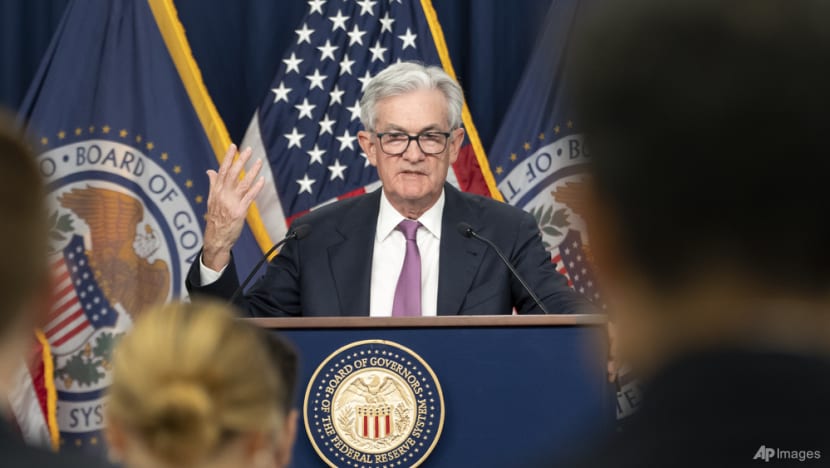Big 'disconnect' between markets and the US Fed on timing of interest rate cuts: Analysts
Some traders are betting that the Fed will cut interest rates by the second half of this year, but the central bank has repeatedly stated its intent to hold tight on rates until inflationary pressures have eased.

SINGAPORE: A mismatch between the United States Federal Reserve's firm stance on stamping out inflation and the market expectations for elevated interest rates to be cut later this year, could make it harder for the central bank to do its job, said analysts on Thursday (Feb 2).
Some traders are betting that the Fed will cut interest rates by the second half of this year, but the central bank has repeatedly stated its intent to hold tight on rates until inflationary pressures have eased.
On Wednesday, the US central bank raised the interest rates by 0.25 percentage point, after a year of larger hikes.
The expectation of rate cuts in the second half of this year “is likely inappropriate and inconsistent” with the Fed’s stated commitment to stamp out inflation, said Dr Sam Chandan, professor of finance at the NYU Stern School of Business.
“But what we clearly see in the market data right now is an expectation that the Fed will begin to pull back and lower rates in the second half of 2023,” he told CNA’s Asia First.
“And I think there's a very real danger here that the markets are misreading the messaging from the Fed. The Fed, in contrast, is signaling as clearly as it can that it will hold tight on rates until those inflationary pressures have subsided substantially.”
FED LIKELY TO HOLD ELEVATED RATES INTO 2024
The central bank will likely hold elevated interest rates through 2023 and into early 2024.
“What the markets may be anticipating is that the economy will slow more abruptly than the Fed anticipates in its own analysis,” said Dr Chandan. “But again, that divergence of the views between the Federal Reserve and the markets is highly problematic.”
On Wednesday, global stocks rose as Fed Chairman Jerome Powell spoke after the Fed announcement.
“Where the Fed I think is again concerned is that we see equity markets continue to improve,” said Dr Chandan.
“We saw a very strong positive response from equity markets today, that is going to make it harder for the Fed to do its job and ultimately could motivate another rate increase after the March and May meetings.”
The Fed said it had turned a key corner in the battle against high inflation, but it would still require its interest rate to stay elevated at least through this year.
“It's just the early stages,” said Mr Powell, who suggested a "couple" more rate hikes to come.
“We're going to be cautious about declaring victory and... sending signals that we think that the game is won, because we've got a long way to go.”
Experts said the Fed is watching the various data points closely to see how the work that they have already done is going to impact the larger economy.
Dr Chandan believes there will be two more rate increases, in March and May, which will see its rates peaking in a target range of 5 to 5.25 per cent.
“This is consistent with what the Fed has been signaling for several months now,” he added.
“And probably where we see the biggest disconnect between the very clear messaging from the Fed and from chairman Powell, and the markets is in the timing around which the Fed may begin to pivot.”
Meanwhile, the labour market remains extraordinarily tight, said experts, adding that that is where attention will be focused on going forward.
INFLATION STILL WELL ABOVE 2 PER CENT GOAL
Inflation is still well above the Fed's 2 per cent target, but is heading in the right direction.
“The time lag with which monetary policy impacts the economy was most likely the main reason for doing less again in the first meeting of 2023. Usually rate hikes are thought to need between three and four quarters to fully show their effect on the economy,” said US economist Christian Scherrmann of asset management firm DWS Group.
“We should keep in mind that the Fed now has a prolonged timeframe until the next meeting in March. Lots of data points on labour markets and inflation are due before then,” he added.
“We do not expect the Fed to be ready to pause in March and another 25 basis point hike then remains highly likely, but an ongoing downturn in economic activity could change the situation thereafter.”
Mr Scherrmann said: “Though economic slowdown might make the case for a pause in the May meeting, a lot of easing in the labour markets is needed before the Fed is likely to prove willing to cut rates.
“The market hopes for this in 2023. We would not expect it until early 2024.”
Mr Kerry Craig, global market strategist at JP Morgan Asset Management, said the risk remains that the Fed wants to see further easing of a tight labour market, given its view that things are out of balance.
“Rate hikes beyond March could drive the US economy into recession, given the downshift in economic momentum that has already occurred,” he added.















